Journal of Pharmaceutical Care & Health Systems
Open Access
ISSN: 2376-0419
ISSN: 2376-0419
Short Communication - (2025)Volume 12, Issue 2
Neurodegenerative diseases, such as Alzheimer’s Disease (AD) and Parkinson’s Disease (PD), are characterized by progressive loss (and even death) of structure and function of neurons and have created great burden to the individual and the society. The actual cause of various neurodegenerative diseases remains a mystery in healthcare. Some of the commonly studied environmental factors causes for neurodegenerative diseases are protein degradation, oxidative stress, inflammation, environmental factor, mitochondrial defects, familial history and abnormal protein accumulation in neuron. However, ageing plays a very important role in neurodegenerative diseases
Diseases; Activity; Drug; Nano; Neurological
Neurodegenerative diseases occur when nervous system cells (neurons) in the brain and spinal cord begin to deteriorate. Changes in these cells cause them to function abnormally and eventually result in the cells' demise. A neurodegenerative disease is a condition that affects neurons in the brain, causing symptoms such as memory loss, moodiness, anxiety, depression and agitation. Treatment for each neurodegenerative disease varies and incorrect treatment may not be helpful or could be detrimental. Some of the most common are epilepsy, Alzheimer’s and other dementias, strokes, migraine and other headaches, multiple sclerosis, Parkinson’s disease, neurological infections, brain tumours, traumatic conditions of the nervous system such as head injuries and disorders caused by malnutrition. The Elevated Plus Maze (EPM) test is used to assess anxiety-related behaviour in rodent models of CNS disorders (Figures 1 and 2) [1-10].
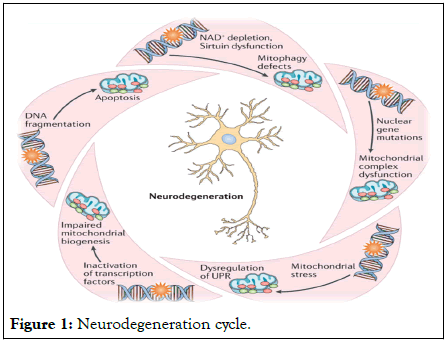
Figure 1: Neurodegeneration cycle.
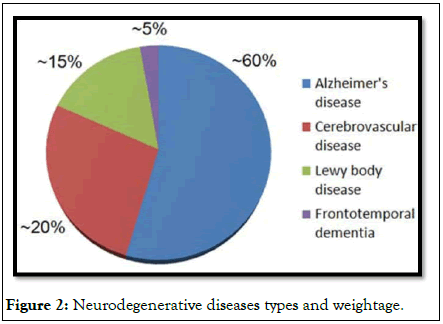
Figure 2: Neurodegenerative diseases types and weightage.
Ginseng
Synonym: Panax ginseng and Chinese herb.
Biological source: Obtained from root of plants in the genus Panax, such as Korean ginseng (P. ginseng), south China ginseng and American ginseng (Figure 3).
Geographical source: It is mainly found in China, Russia, Korea, Japan, Canada and India.
Family: Araliaceae
Chemical constituents: Ginseng saponins, ginseng oils and phytosterol, carbohydrates and sugars, organic acids, nitrogenous substances, amino acids and peptides, vitamins and minerals.
Uses
•Maintaining homeostasis
•Anti-inflammatory
•Anti-oxidant
•Anti-apoptotic
•Immune-stimulatory activities
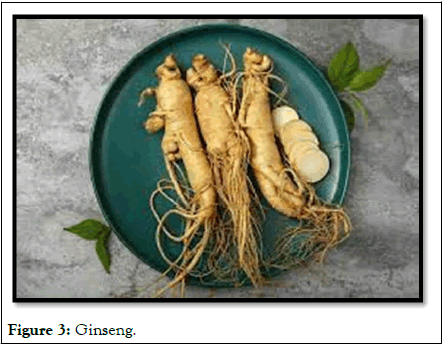
Figure 3: Ginseng.
Ashwagandha
Synonym: Indian ginseng, winter cherry.
Biological source: Obtained from dried roots and stem of Withania somnifera Dunal.
Geographical source: It grows in India, the Middle-East and parts of Africa.
Family: Solaneace
Chemical constituents: This plant contains over 80 typical phytochemicals, including steroidal, alkaloids, saponins, glycosides, and volatile oil. Among these chemical ingredients, sitoindosides and withaferin A had the leading role in WS therapeutic effects (Figure 4).
Uses:
•Improve disease defence
•Prevent aging
•Rejuvenate the body in a vulnerable situation
•Generate a feeling of mental well-being
•Pain and inflammation
•Treat insomnia
•Boost nutrition
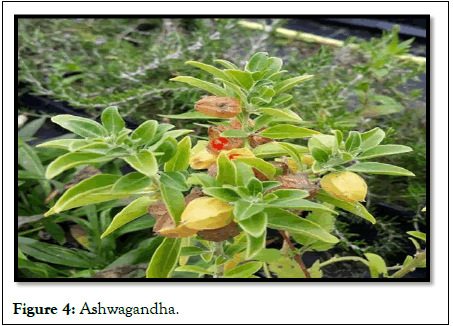
Figure 4: Ashwagandha.
Brahmi
Synonym: Water hyssop, Brahmi, thyme-leafed gratiola.
Biological source: Brahmi is the fresh or dried herb of Centella asiatica (L.) (syn. Hydrocotyl asiatica Linn.
Family: Umbelliferae
Chemical constituents: Hersaponin, apigenin, D-mannitol, monnierasides I-III, plantainoside B and cucurbitacin; the alkaloids brahmine, herpestine and nicotine (Figure 5).
Uses
•Powerful antioxidants
•Improves brain function
•Anticancer
•Neuro relaxants
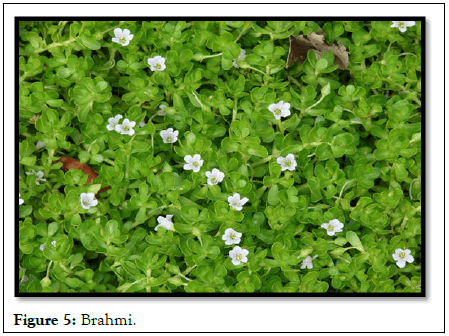
Figure 5: Brahmi.
Ginkgo
Synonym: Maidenhair tree.
Biological source: The leaves of Ginkgo are obtained from the dioeceous tree Ginkgo biloba.
Geographical source: Native to China.
Family: Ginkgoaceae
Chemical constituents: Terpene lactones ginkgo flavone ginkgetin, bilobetin and sciadopitysin (Figure 6).
Uses
•Treat brain
•Circulatory problems
•Respiratory conditions
•Stimulates the cerebral blood circulation
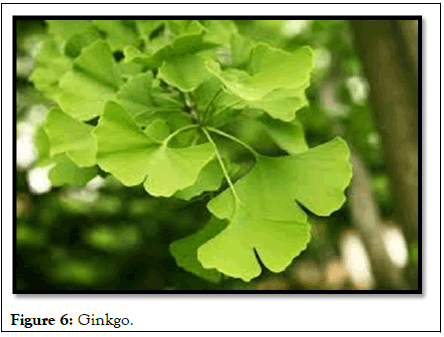
Figure 6: Ginkgo.
Punarnava
Synonym: Hogweed, sterling, tarvine, mukarati kirei and raktakunda.
Biological source: Species of flowering plant Boerhaavia diffusa.
Geographical source: Ceylon, Australia, Sudan and Malay Peninsula, extending to China, Africa, America and Islands of the Pacific.
Family: Nyctaginaceae
Chemical constituents: India and Sri Lanka, Himalaya, China, Malaysia and Africa (Figure 7).
Uses
•Liver disorders
•Urinary tract infection
•Obesity
•Rheumatoid arthritis
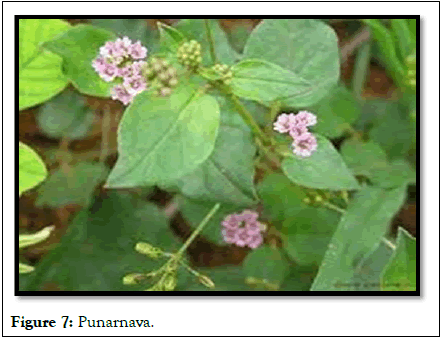
Figure 7: Punarnava.
Wolfberry
Synonym: Boxthorn, matrimony vine, desert thorn and Lycium barbarum or Lycium chinense.
Biological source: Fruit of either Lycium barbarum or Lycium chinense.
Geographical source: Ningxia, China.
Family: Solanaceae
Chemical constituents: Polysaccharides comprise 5%-8% of dried fruits and they are found in the water-soluble form of highly branched L (Figure 8).
Uses
•Anti-ageing activity
•Blurry vision
•Abdominal pain
•Infertility
•Dry cough
•Fatigue
•Dizziness
•Headache
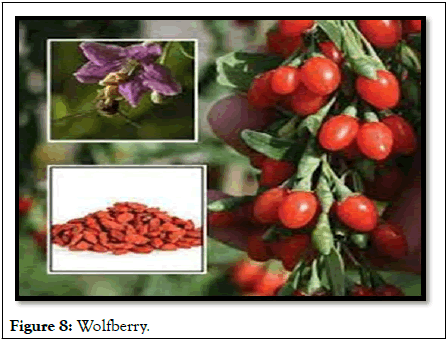
Figure 8: Wolfberry.
Velvet bean
Synonym: Monkey tamarind, Bengal velvet bean and Florida velvet bean.
Biological source: It consists of dried seeds of Mucuna prurines Linn.
Family: Fabaceae
Chemical constituents: L-dopa, steroids, alkaloids, tannins, carbohydrates, amino acid, resins and starch (Figure 9).
Uses
•Nourish the nervous system
•Support healthy sexual energy
•Strengthen and tone the reproductive organs
•Boosts dopamine levels
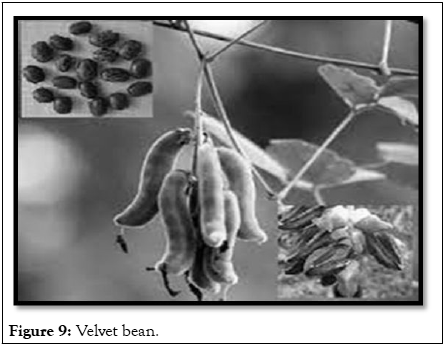
Figure 9: Velvet bean.
Green coffee
Synonym: Java beans, brew berry, roasted seeds, coffee grains and cherry stones.
Biological source: It consists of dried ripen seeds of Coffea arabica Linn.
Family: Rubiaceae
Chemical constituents: Caffeine, tannin, fixed oil, carbohydrates and proteins (Figure 10).
Uses
•Weight loss supplement
•Promote healthy blood sugar and blood pressure
•Positive effect on both short-term and long-term memory
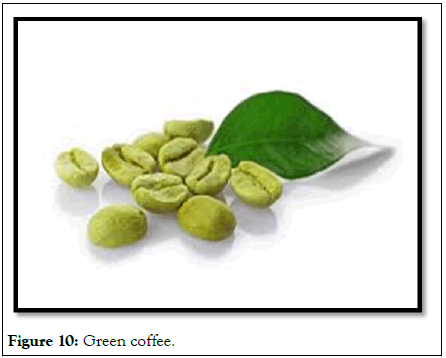
Figure 10: Green coffee.
Drumstick tree
Synonym: Guilandina moringa
Biological source: It is obtained from dried seed/pods of Moringa oleifera.
Family: Moringaceae
Chemical constituents: Chlorophyll b,vitamin C, carotenoids, proteins, amino acids alkaloids, saponins, tannins, steroids, phenolic acids and glucosinolates (Figure 11).
Uses
•Rich in vitamins and minerals
•Rich in amino acids
•Fight inflammation
•Rich in antioxidants
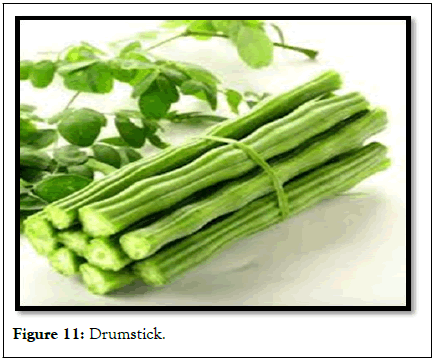
Figure 11: Drumstick.
Sweet flag
Synonym: Vekhand, vaccha
Biological source: It is obtained from stem of Acorus calamus L.
Family: Acoraceae
Chemical constituents: Beta asarone, alpha-asarone and methyl isoeuginol (Figure 12).
Uses
•Gastrointestinal diseases
•Perfume industry
•Memory booster
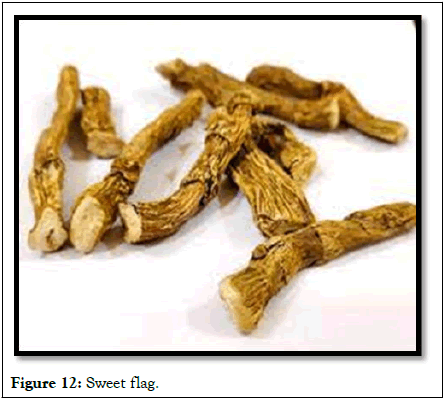
Figure 12: Sweet flag.
Medicinal plants and natural compounds, such as Withania somnifera, Ginseng, Baccopa monnieri, Ginkgo biloba, Centella asiatica, Boerhevia diffusa, Wolfberry have been applied to prevent or alleviate neurological diseases and relief of neurological symptoms reported in in vivo or in clinical trials. Natural compounds in nano size range as a therapeutic agent possess the same activity as in native state.
[Crossref] [Google Scholar] [PubMed]
[Crossref] [Google Scholar] [PubMed]
[Crossref] [Google Scholar] [PubMed]
[Crossref] [Google Scholar] [PubMed]
[Crossref] [Google Scholar] [PubMed]
[Crossref] [Google Scholar] [PubMed]
[Crossref] [Google Scholar] [PubMed]
Citation: Shinde AA, Kannur DM, Joshi A (2025) Golden Herbs Used in Neurodegenerative Diseases. J Pharm Care Health Syst. 11:337.
Received: 05-Dec-2023, Manuscript No. JPCHS-23-28348; Editor assigned: 07-Dec-2023, Pre QC No. JPCHS-23-28348 (PQ); Reviewed: 21-Dec-2023, QC No. JPCHS-23-28348; Revised: 15-Jan-2025, Manuscript No. JPCHS-23-28348 (R); Published: 22-Jan-2025 , DOI: 10.35248/2376-0419.25.12.369
Copyright: © 2025 Shinde AA, et al. This is an open-access article distributed under the terms of the Creative Commons Attribution License, which permits unrestricted use, distribution, and reproduction in any medium, provided the original author and source are credited.